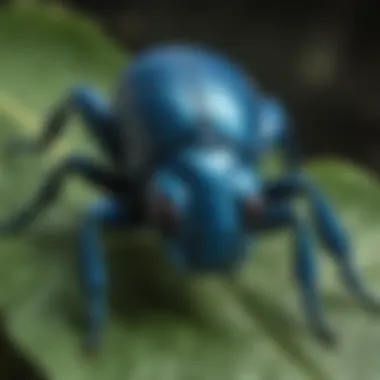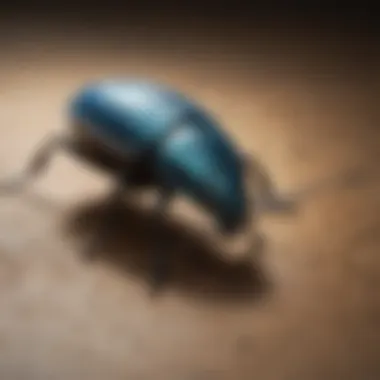In-Depth Insights on Blue Beetle Pest Control Strategies


Preventive Pest Control Strategies
Preventing blue beetle infestations starts before any signs of a problem arise. Adopting a proactive approach can safeguard both your home and yard from these pests.
House Exterior Protection
House exteriors play a crucial role in deterring pests. Specifically addressing vulnerable areas can significantly reduce pest entry.
Tips for Sealing Cracks
Sealing cracks and gaps in the exterior walls prevents pests from accessing your home. Use caulk to fill gaps around windows and doors to create a barrier. Regularly check these areas for wear and reapply when necessary.
Clearing Debris
Removing debris around your home limits hiding spots for pests. Keep your yard and garden neat, cutting down on clutter that can attract blue beetles and others. Regular yard maintenance acts a deterrent.
Preventing Pests from Entering
Install door sweeps to minimize openings for pests. Close all entry points you identify, as blue beetles often find tiny openings to enter. Consider using screens on windows and vents for extra protection.
Yard Maintenance
Maintaining a clean yard is essential for reducing pest risks. Regular care routines ensure a healthy environment and prevent footholds for pests.
Essential Yard Care Routines
Mowing your lawn frequently prevents overgrowth, which can shelter beetles. Trimming shrubs, hedges, and bushes keeps the landscape tidy and reduces potential pest habitat. Aim for about a two-foot clearance between plantings and home's foundation.
Methods for Keeping Yard Pest-Free
Consider planting pest-repelling plants. Some examples include marigolds and garlic; these herbs can naturally deter various insects, creating a protective buffer around your property.
Indoor Cleanliness
Keeping indoor spaces clean is pivotal in pest control. Blue beetles may venture inside when food and shelter are available.
Expert Cleaning Tips and Techniques
Adopt regular cleaning habits, sweeping and vacuuming floors more often to pick up any crumbs and spills. Keep food stored securely in airtight containers to eliminate easy access points.
Maintaining a Pest-Resistant Indoor Environment
Inspect your luggage and parcels once they enter your home. Carrying inside any pest inadvertently can lead to trouble.
Garbage Disposal
Proper garbage management plays a part in pest prevention. Attracting pests with food waste is a serious risk homeowners face.
Efficient Waste Disposal Methods
Keep all garbage cans tightly sealed. Using lined containers can help limit odors and the chances of attracting pests.
Importance of Proper Garbage Disposal
Waste should be disposed of regularly. Avoid allowing garbage to accumulate for prolonged periods, as this can invite beetles and other pests looking for food.
Other Pest Prevention Strategies
Exploring creative approaches nurtures a pest-free household. Protective measures go beyond the basics.
Innovative Ways to Safeguard Your Home
Encouraging natural predators, like birds, may help control blue beetle populations. It supports bio-diversity while serving a practical purpose.
Understanding Blue Beetles


Understanding the biology and behavior of blue beetles is crucial in effectively managing these pests. This knowledge lays the foundation for identifying effective control methods. When house owners get familiar with the specific characteristics of blue beetles, they can better anticipate potential infestations before they escalate. Without a clear grasp of what blue beetles are and how they operate, controlling their presence can reamin largely ineffective.
Species Overview
Blue beetles include various species belonging to the family Chrysomelidae. Commonly known species include the Colorado potato beetle and the tortoise beetle. Each species exhibits unique habits and destruction potential. For example, the Colorado potato beetle primarily feeds on potato leaves, which can be detrimental to agricultural output. Their distinct colors also serve as a warning, signaling their potential danger to plants. Understanding these species helps in scouting and identifying beetles in the first place, which is vital for early intervention.
Behavioral Characteristics
Behaviorally, blue beetles are typically active during warmer months, which contributes to their reproductive cycle. Adult blue beetles can quickly reproduce, leading to rapid population growth if not controlled. Their feeding habits can lead to significant damage to crops and plants. They often choose host plants based on their nutritional needs, leading to preferences that house owners can easily spot. Observations suggest that, during the day, the beetles are often found resting on leaves, which makes them vulnerable to targeted control measures. Recognizing these habits enhances the ability of homeowners to plan effective pest control.
Impact on Environment
Blue beetles can have both negative and positive impacts on the environment. On the downsides, infestations can lead to plant damage and reduced agricultural yield. Crops that are heavily infested display stunted growth and low fruit production. More assertively, certain beetle populations can affect specific ecological niches. Blue beetles, however, can play a role in their ecosystems. They contribute to soil health through their life cycles, particularly when their larvae decompose organic mater. Thus, while they are pests in specific contexts, they may also have inherent ecological significance.
Knowledge of blue beetles not only aids in efficient pest management but also integrates environmental considerations, creating a balanced approach to handling these insects.
The Necessity of Pest Control
When addressing the issue of blue beetles, it is crucial to understand the significance of pest control. Professionals and homeowners alike must recognize that while these insects form part of the ecosystem, they can turn problematic under certain conditions. A proper control strategy ensures a balance between preserving beneficial species and mitigating the risks posed by infestations.
When Blue Beetles Become a Problem
Blue beetles, with their often vivid coloration, might seem harmless or even beneficial in certain environments. However, their population can escalate rapidly, leading to significant destruction, especially in gardens and crop areas. Blue beetle larvae feed directly on foliage, which can stunt the growth of plants and destroy rates of yield in agricultural sectors.
Signs of beetles becoming a problem include noticeable leaf damage and a decline in plant health. Typically, when beetles appear in large numbers, they can lead to reduced crop outputs and lower the aesthetic quality of ornamental plants in private gardens. Intrusive infestations can also render plants susceptible to diseases.
Some common areas where issues arise include:
- Agricultural fields - High-density brown spots indicating severe feeding.
- Home gardens - Altered colors in foliage showing evidence of beetle feeding.
- Lawns and parks - Deterioration of grass quality over time.
Understanding when blue beetles cross the line from tolerable to detrimental emphasizes the importance of effective pest control practices.
Economic Implications of Infestations
The longer blue beetles are allowed to thrive, the greater the potential financial losses from crops and aesthetic gardens.
Infestations can increase the costs associated with pest management and significantly affect local economies relying on agriculture. For homeowners, failing to address beetle problems swiftly can lead to costly landscaping repairs.
Moreover, injured crops may incur losses resulting from reduced yields and may also require additional investments in chemical treatments or biological pest control methods in the future. In fact, some agriculture specialists estimate that for each increased class of infestation intensity, there is a measurable decline in overall profitability of up to twenty percent.
Ultimately, the necessity of pest control becomes clear. Balancing the presence of blue beetles with healthy plant ecosystems is crucial for sustaining both economic viability in farming and aesthetic value in residential areas. Homeowners can greatly benefit from understanding the risk factors associated with these pests; educated actions help maintain thriving gardens and productive crop spaces.
Pest Control Techniques
Pest control techniques are crucial in managing blue beetle populations effectively. Understanding these methods allows homeowners to make informed decisions tailored to their specific needs. It is important for vegetable garden owners, farmers, and home dwellers to identify relevant techniques that can minimize damage and ensure the integrity of crops and living spaces.
Chemical Control Methods
Chemical control methods encompass the use of various pesticides formulated to target blue beetles. These can be effective and quick solutions for infestations, particularly in crops and commercial gardening.
Factors to consider include:
- Active Ingredients: Look for specific ingredients designed for blue beetles like permethrin or neonicotinoids.
- Targeted Application: Using spot treatments helps minimize chemical exposure and is more eco-friendly.
- Follow Manufacturer Instructions: Optimal efficacy relies on correct application. Misuse can create resistance issues within beetle populations.
Remember, timing is essential. Applying chemicals during early infestations minimizes damage better than waiting until populations grow significantly.
Biological Control Approaches
Biological controls exploit natural predators and parasitic organisms that manage blue beetles sustainably. These methods are useful for homeowners desiring an eco-friendly pest management strategy.
Common biological agents include:
- Ladybugs: These beneficial insects consume blue beetle larvae.
- Nematodes: Microscopic worms that attack beetles in larval stages.
- Parasitoids: Certain wasps lay eggs inside or on blue beetles, which helps control populations naturally.
Implementing biological control requires patience. Population reduction may take time, but eventual establishment of these agents offers long-lasting benefits.
Cultural Control Practices


Cultural control practices involve modifying existing management routines to deter blue beetle infestations. It often includes habitat alteration and changes to plant care regimes.
Examples include:
- Crop Rotation: Changing planting sites yearly reduces the risk of beetle buildup.
- Sanitation: Clearing debris ensures no overwintering sites remain.
- Companion Planting: Certain herbs and flowers may repel blue beetles, creating mutually beneficial relationships among crops.
These practices emphasize prevention over reaction. Regular monitoring and proactive measures effectively suppress blue beetle populations.
Integrated Pest Management (IPM)
Integrated Pest Management, or IPM, represents a comprehensive strategy that combines multiple control methods tailored to individual situations. This approach considers the entire ecosystem, emphasizing sustainable practices that promote long-term results.
Key components of IPM include:
- Monitoring: Regular pest assessments to determine the need for intervention.
- Threshold Levels: Establish pest thresholds that warrant action.
- Combination Tactics: Employ a mix of cultural, biological, and chemical techniques as needed.
Implementing IPM not only effectively addresses blue beetle infestations, but it allows for regenerative agricultural practices, reducing environmental impacts. This method serves as a rational strategy to maintain pug_cural balance in both agricultural and residential areas.
Integrated Pest Management contributes to sustainable agriculture. Diverse approaches harmonize with ecological principles, promoting a healthier environment.
Product Reviews
Product reviews play an essential role in the context of blue beetle pest control. They provide insights into the real-life performance of various control methods and products available in the market. Homeowners need to evaluate numerous pests and diseases impacts. This makes well-informed reviews critical because they help to navigate options. Furthermore, understanding how other homeowners perceive effectiveness can be invaluable.
The evolving nature of pest control products requires consistent evaluation. As more solutions are developed, reviews offer an adaptive resource. They assist consumers in comprehensively understanding efficiencies, costs, and whether a product meets their specific needs. Solid feedback can also highlight any potential drawbacks or limitations.
In considering the advantages, product reviews assist in prioritizing safe solutions that minimize environmental impact while effectively reducing pests. Review analysis can contribute to better decision-making particularly when internalizing the experiences shared by other users.
Top Rated Chemical Products
The market offers several top-rated chemical products that are effective against blue beetles. One notable option is permethrin, it serves not just in this context but also against a variety of insects. Another chemical solution is imidacloprid. This offers a systemic approach, ensuring absorption into plant tissues. Considering both can streamline the effectiveness response toward beetle infestations.
It's important to note that these products have specific application guidelines. Adhering to those is most crucial for both efficacy and safety. Moreover, homeowners should consider potential toxicity to beneficial insects when applying these products in an outdoor setting.
Effective Organic Solutions
Organic solutions are rising in popularity among environmentally-conscious homeowners. These alternatives include substances such as neem oil and diatomaceous earth. Neem oil works as both a pesticide and fungicide, hindering the beetles without the harmful side effects of traditional chemicals. On the other hand, diatomaceous earth acts by dehydrating insects, providing another means of controlling populations.
Using effective organic solutions whispers assurance in pest management. One significant benefit is the minimized risk of chemical contamination in gardens and home environments. Moreover, these solutions often have a shorter waiting period before resuming contact with treated areas.
User-Generated Feedback on Commercial Products
User-generated feedback on commercial products can be enlightening. Most homeowners report basic functionality discoveries. Platforms like Reddit allow active discussions on multiple options available, nurturing a communal exchange of personal trials, errors and successes.
Reviews reveal insights that center around ease of use, application frequency, and efficacy over time. Some consumers praise Spectracide Triazicide, noting its ease of application and effective results. Others prefer relying on Garden Safe solutions, articulating an affinity for its lower impact on nearby plant life. Such experiences reflect varied outcomes depending on the specific conditions where products are utilized.
Consumer testimonials serve as a rich narrative of each product's reality, transcending mere marketing information available in product descriptions.
Understanding the full perspective—from chemical reliance to embracing organic options—creates a broader toolset for homeowners facing blue beetle challenges.
Evaluating Effectiveness
Evaluating the effectiveness of blue beetle pest control strategies is essential for a variety of reasons. Understanding how well these methods work helps homeowners realistically assess their options. Furthermore, an effectiveness evaluation can lead to better decision-making in terms of resource allocation and method selection. Through this examination, individuals can prioritize their efforts, preventing the situation from worsening while effectively managing their pest control needs.
Consumers improve their approach by recognizing the beneficial aspects and limits of each method. They may favor a more straightforward solution while weighing cost-effectiveness and long-term impact. Furthermore, understanding performance metrics provides insights into the specific outcomes that can be expected after the implementation of particular techniques. The depth of evaluation helps reveal patterns in various methods, guiding homeowners in enhancing their pest management tactics.
Performance Metrics
Measuring the performance of blue beetle control methods involves specific key performance metrics. These metrics provide clarity on the overall effectiveness and may influence how home owners choose to proceed.
Commonly Used Performance Metrics Include:
- Kill Rate: This is the percentage of beetles killed by a specific method over a stipulated period. It indicates how lethal a product is in practice.
- Time to Effect: This metric assesses how quickly the method delivers results. Fast solutions are often prioritized by beekeepers and business owners aiming for immediate action.
- Reinfestation Rate: Evaluating how often beetles return after treatment reveals the long-term effectiveness of the method. A zero reinfestation rate indicates that the treatment not only removed existing beetles but also prevented new ones.
- Expansiveness of Impact: This looks at the area of influence a intervention can have; How quickly and effectively it can serve large spaces versus small, contained spots.
These measures, paired with anecdotal evidence from users, help paint a comprehensive picture of performance regarding pest control options.
Long-term Impact on Beetle Populations


Understanding the long-term impact of various pest control methods is critical in establishing sustainable strategies. Some solutions may provide immediate results but don’t offer lasting control. It’s essential to consider whether methods are targeting the reproductive processes or life cycle stages of blue beetles effectively.
- Sustainability: Eco-friendly methods, while initially appearing less effective, often yield better long-term results because they do not contribute to resistant beetle populations. Resistance can reduce overall effectiveness as young beetles develop tolerance to certain pesticides.
- Overall Population Dynamics: Monitoring and evaluating beetle populations over extended time periods sheds light on trends and helps identify effective strategies.
- Environmental Changes: As pest control strategies are implemented, it is crucial to adapt methods if conditions in the environment change, whether due to climate influences or urban developments. A flexible approach can ensure longer periods of management success.
@ Evaluating control methods over both short-term and long-term is vital in maintaining these structures. Evaluating Reinfestation rates and Population behavior over time provides insights for homeowners investing in sustained management practices.
This understanding can foster stronger, more sustainable outcomes, helping achieve significant reductions in persistence and usability of pests, including blue beetles, across contexts. Homeowners can thrive in an environment less interrupted by pest infestations.
Case Studies
The inclusion of case studies in this analysis allows for a deeper understanding of how blue beetle infestations occur in different contexts and how various strategies can effectively mitigate their impact. These real-world examples can help homeowners and pest management professionals alike assess the factors leading to infestations, analyze the roles of urban and rural settings, and learn from prior successful pest control efforts.
Effective case studies offer tangible evidence of the effectiveness of pest control methods, revealing strategies that homeowners can utilize in their own exposure. Additionally, the benefits of understanding these experiences lie in the ability to draw applicable lessons on prevention and responsive actions that are context-dependent.
Urban Versus Rural Infestations
The dynamics of blue beetle infestations differ significantly between urban and rural environments. Urban settings might experience beetle problems because of dense human populations, leading to increased food sources and host plants in ornamental gardens. The challenge often lies in the limited space for the implementation of control strategies and the multitude of adjacent properties that can harbor pests.
On the other hand, rural areas provide larger expanses of agricultural land, which can amplify beetle infestations while complicating damages significantly. Farmers face the risk of substantial losses in crops if infestations go unchecked. Such settings are also common for various insect species acting as aggressors.
In urban areas, localized education about favorable beetle habitats is critical for efficient pest management.
Through careful examination of case studies focusing on these areas, many solutions emerge such as landscape management and adherence to agricultural best practices. It becomes essential therefore for efforts adapted to each locale regarding cultural control or chemical products.
Successful Pest Management Stories
Real-life examples pave the way for innovative and effective strategies by showcasing what was tried and tested. Various accounts provide motivating narratives for homeowners experiencing infestations themselves. Successful pest management stories include instances where localized actions were meticulously observed and executed.
For instance, community-driven initiatives in neighborhoods often yield impressive results. Residents collaborate to implement an Integrated Pest Management approach that emphasizes understanding specific beetle behaviors and defending against potential infestations through strong communication and sharing of responsibilities.
Handling blue beetles successfully often also involves relevant pest control products, such as those manufactured with user-friendly instructions and effectiveness ratings. Homeowners adopting organic techniques found pleasant surprise in their outcomes when combined with consistent outdoor maintenance routines.
One case from a local garden club highlighted that by planting resistant plant varieties and encouraging beneficial insects, blue beetle populations could decrease over time significantly. Such stories invigorate hope and motivate homeowners to explore sustainable strategies for pest control.
These case studies illustrate that awareness, preparedness, and community engagement can yield remarkable success in tackling the implications of blue beetle infestations. As readers review these narratives, the connection between individual efforts and collective impact becomes evident, ultimately advancing thoughtful discussions on effective blue beetle management.
Future Directions in Beetle Control
Exploring future directions in beetle control is crucial for effective pest management in various environments. Understanding the trends and advancements in pest control technology aids homeowners in adopting methods that are not only more impactful but also safe for the environment. For effective eradication of blue beetles, future methodologies must include comprehensive approaches utilizing cutting-edge technology and sustainable practices.
Innovations in Pest Control Technology
Technological advances are reshaping how we approach pest control. Techniques such as remote sensing, artificial intelligence, and data analytics are gaining importance in tracking pest populations and predicting infestations. For example, drone technology can survey large agricultural lands quickly and efficiently. By capturing real-time data, it allows farmers and homeowners to pinpoint areas of infestation more accurately. This proactive approach saves time and reduces the neccessity of broad-spectrum pesticide use.
Additionally, the development of smart traps equipped with sensors can differentiate between beneficial and harmful insects. This precision helps target blue beetles specifically while preserving useful pollinators. Such innovations lead to a shift from reactive to preventive measures, offering a more sustainable approach to pest control.
Sustainability Considerations
Sustainability is pivotal in progressing beetle control methods. Homeowners and agricultural stakeholders need to embrace eco-friendly practices. Rather than relying solely on chemical solutions, thinking in an environmentally friendly way will minimize adverse effects on local ecosystems. Organic pesticides, such as neem oil or insecticidal soap, provide alternatives that are less harmful to beneficial species.
A crucial consideration is the integration of Integrated Pest Management (IPM). This strategy combines various control tactics, involving cultural, biological, and mechanical controls, in addition to appropriate pesticide application. IPM promotes environmental stewardship while ensuring effective pest control.
Sustainable practices create a balanced ecosystem that not only discourages blue beetle infestations but also enhances biodiversity.
Finally, increasing consumer awareness and education on pest management technologies will improve adoption rates. Encouraging discussions about innovative methods within communities can lead to a collective approach to pest management, benefitting everyone involved.
Ending
The importance of the conclusion in this article cannot be overstated. It serves as a synthesis of all the key points covered throughout the publication. It emphasizes the complex nature of managing blue beetle infestations, illustrating the urgent need for effective pest control strategies that can shield homes and gardens from the damage caused by these pests.
Key Benefits to Consider:
- Summarizes Critical Information: Readers get a concise review of the main topics discussed. This aids in retention and clarity.
- Guides Future Action: The conclusion provides both decisive insights and general guidance on what direction homeowners can take in pest management. It's essential that readers feel empowered to take action based on provided methods and findings.
- Encourages Ongoing Learning: It opens the door for continued exploration and learning. Understandable control strategies should inspire further research and implementation, leading to long-term solutions.
Understanding and acting upon pest control insights ultimately safeguards one’s home while promoting a healthier environment for all.
Key Takeaways
- Recognizing the various species of blue beetles is crucial for selection of effective pest control strategies.
- Economic consequences of infestations illustrate that early intervention is prudent for financial health.
- A combination of chemical, biological, and cultural control methods yields better results than relying solely on one approach.
- Homeowners must stay informed of new products and technologies developed for pest control in significant consumer feedback loop.
Recommendations for Homeowners
- Prioritize Early Detection: Check your garden and home regularly for signs of infestations. Early intervention improves chances of successful control.
- Choose the Right Products: Be informed of the various chemical and organic solutions available. Each product has specific requirements for optimal effectiveness.
- Implement Integrated Pest Management (IPM): This strategy combines different methods for greater efficacy. It minimizes chemical use while considering environmental impacts.
- Stay Educated: Follow reliable resources like Wikipedia and forums on Reddit to keep abreast of new findings and consumer reviews in pest control.
- Seek Professional Advice: If infestations become severe or difficult to manage, highly recommended to consult a pest control specialist who understands local species and the best management practices for them.



